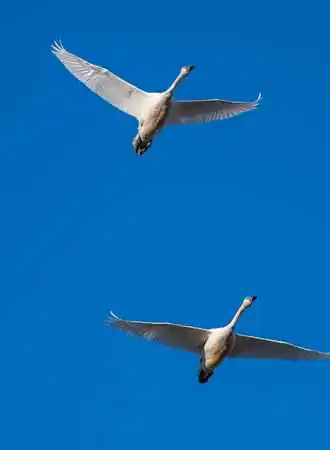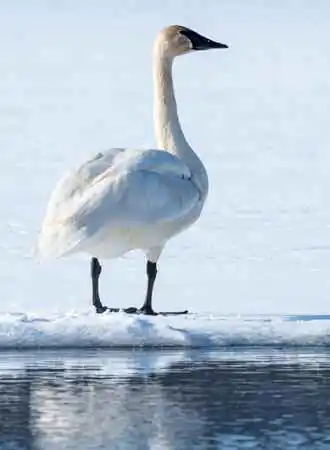Out of the three swan species found in North America, the trumpeter and tundra swans are migratory, while the non-native, introduced mute swan is non-migratory. These beautiful birds undertake impressive journeys each year, traveling thousands of miles between their breeding and wintering grounds.
If you’re interested in learning more about the migratory habits of swans, keep reading! In this article, we’ll answer many questions related to swan migration and delve into the reasons behind these epic journeys.

Key Takeaways on the Migration of North American Swans
- Two swan species native to North America, the tundra and trumpeter swans, migrate south in the winter.
- Swans of the northern hemisphere use different migration routes to reach their wintering grounds when ponds, rivers and lakes freeze.
- The trumpeter swan is the largest native waterfowl in North America.
What are the swan species of North America?
Tundra Swans
The Tundra Swan, also known as the whistling swan, lives in tundras, coastal wetlands, and mountain areas in the summer but migrates south in the winter. Its northernmost habitat range extends from Canada to Alaska, while its southern range includes many parts of the US and Central America, as well as countries in northern Europe and Asia.
During migration, Tundra Swans can be found along the coastline or on large inland lakes such as the Great Lakes.
The Tundra Swan’s diet consists mainly of aquatic vegetation, seeds, and insects found near water bodies such as shallow wetlands, lakes, rivers, ponds, or marshes. It also eats small fish, shellfish, and crustaceans when available, along with some amphibians such as frogs or newts.
Like other waterfowl species, tundra swan cygnets are precocial, meaning they have already developed many skills necessary for life within their species. These young swans can feed and swim shortly after hatching, displaying remarkable independence early in life. This kind of development is well-suited to the cold climate of their natural habitat.

Trumpeter Swans
The Trumpeter swan has a long, slender neck and a large, triangular-shaped head. Its bill is black and slightly curved, and its eyes are brown. The swan’s wings are white, and its legs and feet are also black. It is the largest waterfowl species in the world.
Male trumpeter swans can weigh up to 28 pounds, making them the world’s largest water birds.
Trumpeter swans are found in various habitats, including marshes, wetlands, and shallow ponds. They are migratory birds, and during the winter months, they can be found in the southern United States, including Texas, Arkansas, and Oklahoma.
In the wild, Trumpeter swans mostly feed on aquatic vegetation like water lilies and pondweeds. They may also eat small fish, insects, and other small invertebrates. Trumpeter swans have a varied diet and eat grains, berries, and other plant matter when available.
Mute Swans
The mute swan (Cygnus olor) is a large waterfowl native to Eurosiberia, known for their long necks and bright orange bills. It is an introduced species in the US, with the largest population outside its native range. They are widespread in the United Kingdom and other parts of western Europe.
Mute swans are found in various habitats, including marshes, wetlands, and shallow ponds. They are non-migratory birds but take short-distance flights to find better food sources.
In the wild, mute swans mostly feed on aquatic plants, such as water lilies and pondweeds. They may also eat small fish, insects, and other small invertebrates. Mute swans have a varied diet and eat grains, berries, and other plant matter when available.
Mated pairs of mute swans are known for their aggressive behavior, often attacking people and other swans approaching their nesting territory.

Are there whooper swans in North America?
The whooper swan is a majestic bird that is primarily found in Eurasia. Despite not being a native of North America, it is occasionally seen along our Pacific Coast during the winter, especially in the vicinity of the Aleutian Islands, from Alaska to California.
Reports of sightings are few, but they are significant because of the animal’s impressive size, which can approach the dreaded trumpeter swan.
Are there black swans in North America?
No, there aren’t black swans in North America. Black swans are native to Australia, so if you see a black swan in the US or Canada, it is most likely an escapee.
However, some vagrant black-necked swans have been sighted in the southern parts of the US. The black-necked swan is native to South America.

Are all swans migratory?
In North America, there are three species of swans: the trumpeter swan, the tundra swan, and the mute swan. While all three are large and graceful birds, only two of them migrate. The trumpeter swan and tundra swan have a migratory pattern, while the mute swan is non-migratory. Interestingly, the two species look similar from afar.
The whooper swan, which occasionally visits the continent’s northern regions, is also a migratory species.
When do swans migrate?
Like other migratory birds, swans in North America typically migrate during the winter months, with some species beginning their migration in late October or November and returning to their Arctic breeding grounds in February or March.
The exact timing of swan migration can vary depending on several factors, including weather conditions and food availability.
For example, swans that migrate to more southern locations may begin their migration later in the fall and return in the early spring when nest building usually starts, while swans that migrate to more northern locations may begin their migration earlier in the fall and return later in the spring.

Can swans survive extremely cold weather?
Most swans of the Arctic tundra can survive cold weather, as they are well adapted to living in cold climates. Their bodies are covered in thick feathers, which provide insulation and help to keep them warm in cold temperatures.
Swans also have a layer of fat under their skin that can help to keep them warm and provide energy during the winter months.
In addition, swans can change their metabolism in response to cold temperatures, allowing them to conserve energy and stay warm.
However, most of them can’t survive in extremely cold weather. They are at risk of getting frostbite in the bitter cold.
If swans can survive cold weather, why do they migrate in winter?
Swans migrate in the winter to find food and suitable living conditions. In many parts of North America, the winter months bring cold temperatures and shorter days, making it more difficult for swans to find food.
Swans typically feed on aquatic plants, which may be less abundant in the winter due to the colder temperatures and shorter days. As a result, swans may migrate to areas where food is more readily available.
In addition, swans and other wildlife may migrate to escape harsh weather conditions or to find open water in areas where lakes and ponds may freeze over.

Where do the swans go in the winter?
The eastern and western populations of these migratory swans follow different migratory routes but most routes follow the Mississippi river and Great Basin. Small flocks of the eastern population may also use the Atlantic flyway.
During the winter months, many trumpeter and tundra swans in North America migrate to the southern parts of the United States. These migratory birds often travel in large flocks, heading towards more temperate climates with abundant food supply.
Some trumpeter and tundra swans, along with other species of birds, may migrate as far south as the Gulf Coast region, while others may go to the southern Great Lakes area, the Mississippi Valley region, North Dakota and southern parts of Texas.
The western population that breeds in Alaska spends winters in the Pacific Northwest, British Columbia and southern California. You can see more swans use Vancouver Island as a stopover point during their migrations.


